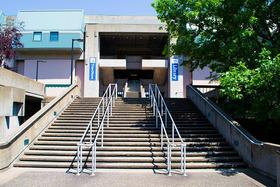The coronavirus pandemic has hit the country hard, but it has been particularly difficult for America’s working class. Low-wage jobs were eliminated by the millions and people without college degrees faced the highest rates of unemployment. Over a year into the pandemic, community colleges – the education system created to help America’s working class – continue to struggle.
According to data from the National Student Clearinghouse, enrollment has declined by nearly 10% at over 1,000 two-year colleges since last spring. Added to a similar drop in enrollment last fall, these numbers more than double the decline in enrollment seen at four-year colleges and universities. Enrollment has declined even more sharply among Black and Hispanic students.
These numbers hint at the many ways the COVID-19 pandemic has affected community colleges and highlight the challenges these schools face if they are to survive. Keep reading to learn more about the current state of community colleges in the U.S. and what the future may hold for them.
Which States Have Been Hit Hardest?
The COVID-19 pandemic hasn’t left a single corner of the world untouched but under the Trump administration the United States saw millions of deaths which left the country in shock. Around the country, students were forced to choose between abandoning their plans and enroll in college or accept an altered version involving remote education. Nearly half of all American households report that a prospective college student cancelled their plans to attend community college in the fall of 2020. Families with prospective four-year students only saw a 20% rate of cancelation.
Whttps://www.careercast.com/jobs-rated/highest-paying-jobs-2015hile every state was hit by the COVID-19 pandemic, some have fared worse than others in terms of prospective enrollments. According to a national survey conducted by the U.S. Census Bureau, the five states most heavily impacted are as follows:
- Alaska
- Colorado
- Montana
- Nevada
- Oregon
Using census data, the Community College Research Center (CCRC) has delved deep into the issue to determine which states are still struggling and what factors impact variations in enrollment. Here are the top three reasons the CCRC suggests disruption to college plans varies by state:
- The timing and severity of virus transmission, including public policies and responses.
- Educational differences, particularly the availability and affordability of programs.
- Labor market variations in terms of job opportunities and wages for workers with differing college credentials.
Throughout the country, the coronavirus pandemic has put disparities in public education in the spotlight and, in many communities, gaps in educational equity have widened. In many states, the coronavirus has also widened the gap between community colleges and four-year colleges. For example, community colleges in New Mexico and Connecticut have approximately the same cancellation rate but four-year schools in New Mexico have a much higher rate than four-year schools in Connecticut.
Challenges Community Colleges Face in the Pandemic
Every community college is unique, as are its students. Community colleges are designed to serve the community, especially its working-class citizens who seek an affordable means to obtain a higher education degree to improve their employment opportunities and earning potential. Community colleges around the country have seen an average 10% decline in enrollment due to two primary concerns among current and prospective community college students:
- Concerns about getting or spreading COVID-19
- Concerns with paying for college during the pandemic
In a national survey, over one-third of households with current or prospective community college students cited the coronavirus as a primary concern affecting their college plans. Households expressed concern over contracting the virus, spreading it, or caring for someone who has it as a major factor affecting their decision. Only one-fifth of households with current or prospective four-year college students expressed these concerns. Massachusetts, Ohio, and Michigan showed the highest disruption in college plans due to concerns about the virus.
On top of concerns about contracting or spreading the virus, many households also expressed concerns about paying for college during the pandemic. Reduced family income and/or difficulties accessing financial aid played a key role in the decisions of nearly one-third of community college families on a national scale versus under one-fifth for four-year college families. While the pandemic has made all types of college less affordable in most states, certain states like New Mexico, Alaska, and Texas have the highest level of concern.
How One LA Community College Survived the Pandemic
The coronavirus pandemic has changed the face of the American education system and educators around the country are struggling to decide how to move forward. With schools all over the country facing double-digit drops in enrollment, it’s become clear that the industry will have to adapt if it hopes to survive. On Los Angeles community college started taking steps two years before the pandemic began to change their school’s approach to enrollment and those steps may be what saved the school.
Los Angeles City College (LACC) was founded in 1914 and quickly became an essential institution of higher education in Southern California. By 2018, however, the school had begun to flounder. Mary Gallagher, the new college president, cites financial problems related to enrollment problems as a key factor. The college had always felt like a family, but it had lost its way, losing 13% of its students between 2014 and 2018 – a time when statewide community college enrollment was growing.
With her history in customer service and business administration, Gallagher transformed the college’s outreach program with a more customer service-centered approach. The school turned an old welcome center into the headquarters for the First Year Experience program, rolling out call centers and chat services to answer questions for incoming college students. The program also includes onboarding classes during the summer before a student’s first semester.
While LACC’s efforts were extremely successful (the school lost almost none of their students during the fall semester), Vice Chancellor Ryan Cornner comments that the school’s strategies may not produce the same results in other areas. The neighborhoods surrounding LACC’s other campuses – Los Angeles Southwest College in particular – were hit disproportionately by the pandemic. Los Angeles Southwest College is located in an unincorporated part of Los Angeles near Inglewood that has limited access to healthcare and high poverty rates.
Tatiana Melguizo, a USC education researcher, notes that the bulk of students suspending their higher education are Black and Latino students. Students who are struggling economically have to focus on basic needs rather than looking for higher education. Melguizo suggests the answer to the problem is increasing availability of financial aid and liveable wage jobs for students in these communities so they don’t have to choose between education and basic necessities like housing and food.
The Impact of COVID-19 on Transfer Students
Not only has the COVID-19 pandemic affected prospective community college students, but it has led many current students consider transferring to schools closer to home. Not only are public state and regional colleges more accessible, but they are generally much more affordable than out-of-state private institutions. Community colleges, already hungry for enrollments, may finally have the motivation they need to fix the deeply flawed transfer system.
According to a OneClass survey, about 35% of students stated they planned to withdraw from their current school if remote learning was the only option available. Many of those students indicated they would choose a community college instead. Transferring to community college gives students the benefit of being closer to family as well as having smaller class sizes and lower tuition, but transfer students are always at risk for losing credits when switching from one school to another.
Estimations from the U.S. government’s General Accounting Office suggest that transfer students lose an average of 43% of their credits. Transfers can also lead to challenges with financial aid, especially in cases where eligibility is affected by the student’s class load. Again, these challenges magnify the inequities that are already present in the community college system. Only about 13% of students actually earn a bachelor’s degree while 8 out of 10 aspire to do so, according to data from the National Student Clearinghouse Research Center. For low-income students, its closer to 10%.
Stakes have never been higher for community colleges to bring in new students, but research suggests the students who are least likely to return to school are those community colleges are trying hardest to attract. This begs the question – could the pandemic force community colleges to make changes to remove the stumbling blocks that have affected so many students?
The transfer process has always been difficult for college students, regardless of whether they attend a community college or a four-year institution. No college wants to lose students, but the pandemic has been challenging across the board. The best thing institutions can do is provide support for students who want to transfer, suggests Richard DeCapua, vice president for academic affairs for OneClass. Transfer offices should provide students with a list of courses at local community colleges that can be applied to their majors and keep the student’s contact information so they can be recruited back later.
Another challenge affecting transfer students in and after the pandemic is that many courses were switched to pass/fail as many students were evacuated from campus and forced to continue their education online. Many four-year colleges don’t accept pass/fail credits for transfer which could further complicate things. Some states have already taken steps to remedy the issue. New Jersey, for example, has launched it NJ Come Home campaign which promises any participating college will accept transfer credits from accredited out-of-state four-year schools if the student gets a C or higher.
It’s not uncommon for students to attend community college part-time during the summer while attending four-year schools during the year. While many community colleges treat these transfer students as second-rate, leaving them to their own devices for the most part in choosing classes, Davis Jenkins, senior research scholar at the Community College Research Center, suggests community colleges could benefit from treating these part-time students as potential full-time students. Jenkins says schools should work with transfer students to help them complete more of their degree locally.
Community Colleges May See an Increased Need for Remedial Education
In addition to providing students with a local opportunity to complete required courses, community colleges also offer opportunities for remedial education or developmental education. During a recession, community colleges typically see a rise in enrollment, particularly among adults who are going back to school to learn new job skills.
Data suggests as many as two-thirds of entering community college students and over one-third of new four-year college students require some degree of remedial education, especially in math and language skills. These students are often referred to one, two, or even three developmental education courses to help them prepare for college-level courses. Though many students seem to be unprepared for college-level education, research from the past decade suggests fewer than 30% of students who take developmental education courses end up earning their degree within eight years. In fact, many drop out before finishing the course and enrolling in college-level courses.
As concern grew among educators and legislators in the 2010s, many states started to reform their developmental education programs. This gave rise to the conception of corequisite courses. Basically, students take college-level courses at the same time as taking developmental education courses. According to Complete College America, this approach has yielded drastically improved results. By 2016, eighteen states were slated to incorporate corequisite programming and many started implementing those plans but then the 2019 global pandemic hit.
The COVID-19 pandemic has highlighted and exacerbated many of the flaws in our education system. As the country starts to recover from the pandemic, it is essential that we address these flaws and be proactive in supporting the students who have experienced significant learning gaps due to the pandemic. Developmental education opportunities may become more of a necessity to help traditionally underserved students get back on track with their degree programs.
What Can Community College Students Expect in a Post-Pandemic World?
For students who manage to complete their degree during the pandemic, the world they enter will be greatly changed. Months of quarantine and social distancing have changed the world as we know it. The job market is one of the worst we’ve seen in decades and the unemployment rate for young adults aged 16 to 24 was over 11.5% at the beginning of the year. These changes have led many graduating college students to change their perspectives on life and work after graduation.
Millions of wage workers lost their jobs during the pandemic and at the start of 2021, over 40% of the U.S. labor force was working remotely. Many graduating college students no longer feel drawn to major urban areas like Washington D.C. and New York City to find a job after graduation. The pandemic has created distrust for the U.S. jobs market among graduating students, leading many to make the decision to create their own opportunities by starting a business.
Johayra Diaz, an academic advisor at Montclair State University, encourages students who are considering changing their career path do their homework. The suggests they look at the curriculum for the majors they’re interested in switching to and decide whether the program will meet their needs. Students should always meet with their academic advisor prior to making any changes and talk to the financial aid office to see whether a switch would affect their financial aid. She also encourages students to research the job market and determine whether their new career will meet their expectations.
In Conclusion
The global pandemic has affected all of us and thrown the world into disarray. Even as COVID vaccinations are distributed and people return to work, the lingering effects of the pandemic will likely be felt for years to come. Community college students have been forced to amend their educational and career plans and colleges themselves are faced with the challenge of declining enrollment. The future remains uncertain, but each passing month puts us on the path to recovery.
Both current and prospective community college students must be flexible but pragmatic about the lasting effects the pandemic has had on their education and their future career goals. Perhaps the pandemic will motivate students to become more proactive and schools to focus more on the needs of their students. Only time will tell how the U.S. education system arises from such a challenging time, but we can hope it will change for the better.












